A RevolverGuy shared these older Colt ads with me, and I really enjoyed looking at them.
More than just beards, tattoos, helicopters and lipstick
Perhaps one of the things that I liked the most about them was their tone. The Marketing guys were definitely trying to sway your opinion and endear their products to you, but they did it in a way that seems very different from most advertising today.
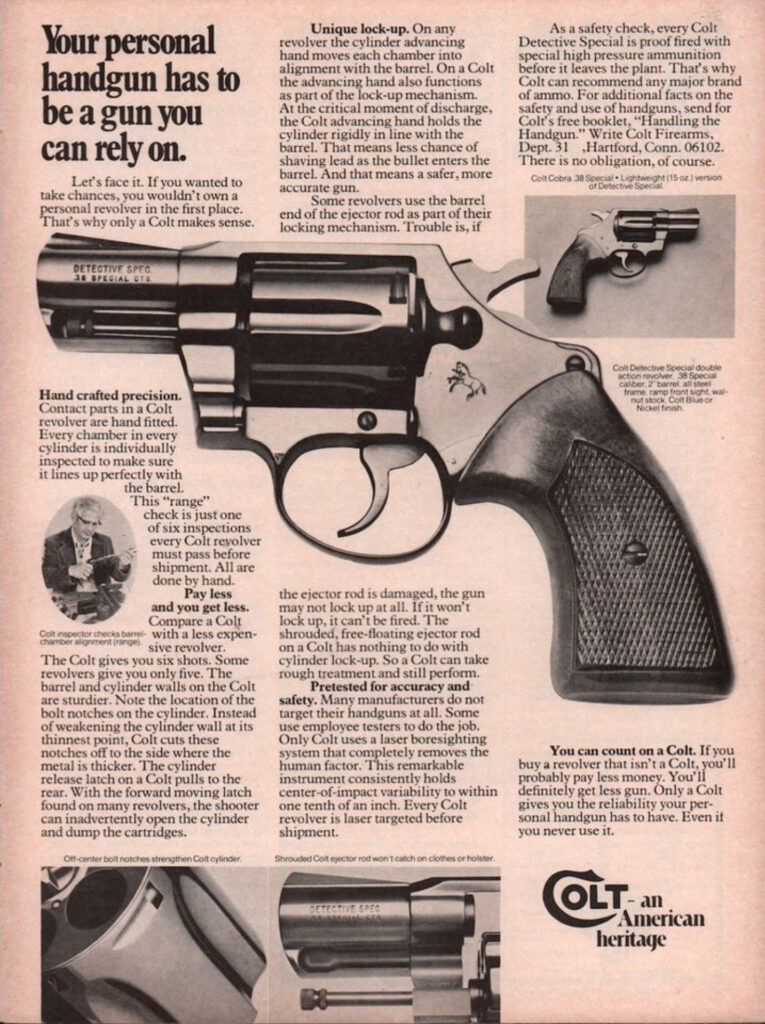
In these ads from the ‘70s to the ‘80s, the reader is treated like an intelligent person, and is presented with a technical argument that explains why the product is superior. There’s actually some substance in these ads—something which is sorely lacking in most advertising today, which seems to be more focused on flashy images and cosmetics. Could it be that the marketers of previous eras had more respect for their customers? That they once felt a need to appeal to your reason, more than your emotions?
Color me crazy, but I think the older model is a lot more useful than the colorful, but superficial ads you’re likely to see in a gun magazine these days, and it’s certainly far better than some bizarre ad that says I’d have to be willing to drink my own urine to qualify to buy the product.
Interesting details
One of the most interesting things about the old Colt ads is to see some of the arguments they made in favor of their design (beyond the obvious benefit of having six shots in a small frame). In an era where competition was stiff between Colt and Smith & Wesson, the Colt team did a good job of highlighting what they perceived as the advantages of their guns over the other marque, to include:
-
A barrel with more lands and grooves, which they claimed made the guns more accurate;
-
An ejector rod that didn’t have a forward lockup at the tip. Colt argued this made the gun more reliable, because a bent rod wouldn’t prevent the cylinder from closing or locking up;
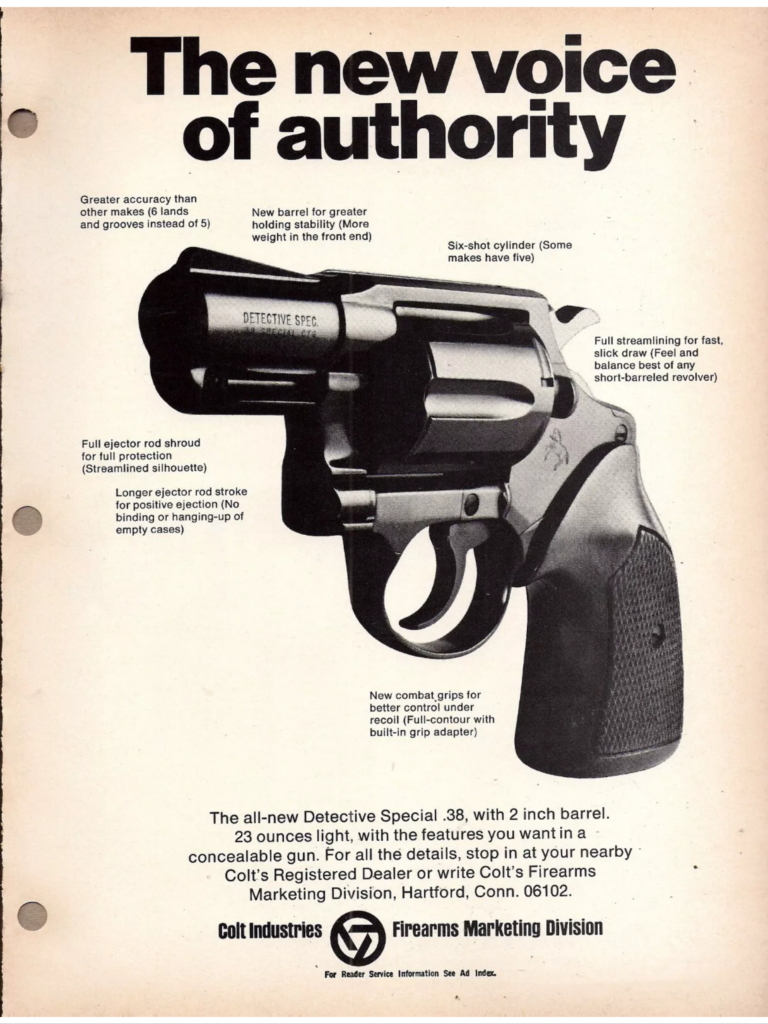
-
A longer ejector rod stroke, for more positive ejection;
-
A cylinder release that was activated by pulling it to the rear, which made it less likely to be inadvertently bumped during recoil, thus opening the cylinder and disabling the gun;
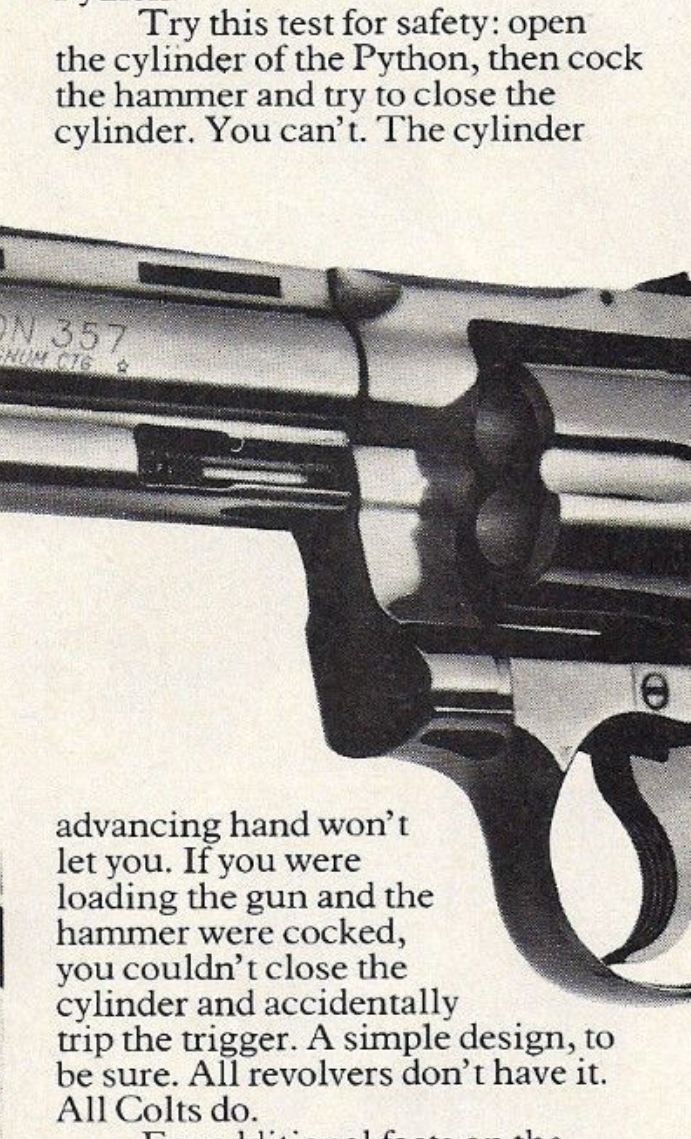
-
Cylinder bolt notches that were cut in between chambers, where the cylinder walls were thickest, instead of on top of the chambers, which eliminated a potential weak spot;
-
A locking system where the hand helped to hold the cylinder in place during ignition, thus making the lockup stronger and more repeatable, which enhanced safety and accuracy, and;
-
A cylinder which could not be closed while the hammer was cocked, for enhanced safety.
Pride
There was also a genuine pride in craftsmanship that was displayed in the old ads. Colt emphasized the quality of their materials, the precise manner in which their guns were fitted, and the beauty of the woods and metal finishes you’d find on your gun. Today, we might expect an ad to boast how a serviceable, but dull and unattractive, finish is “maintenance free,” but the Colt ads of the era recognized that these guns were more than just tools; They were functional works of art, that were to be appreciated for both their performance, and their aesthetics.
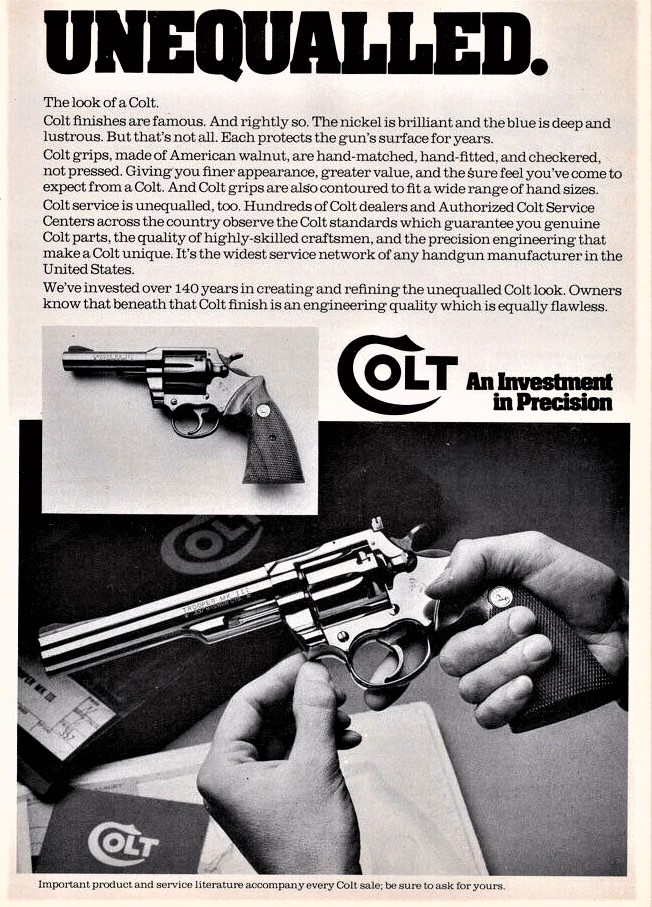
better times
We don’t see technical and craftsmanship differences like these being discussed as much in today’s advertising, and I think the audience is poorer for it. We also don’t see ads that are nearly as entertaining as the clever face off between Smith & Wesson and Ruger, back in the 80s.
Wouldn’t it be neat if we saw some useful and fun ads like these make a comeback, someday?
A RevolverGuy can always hope . . .

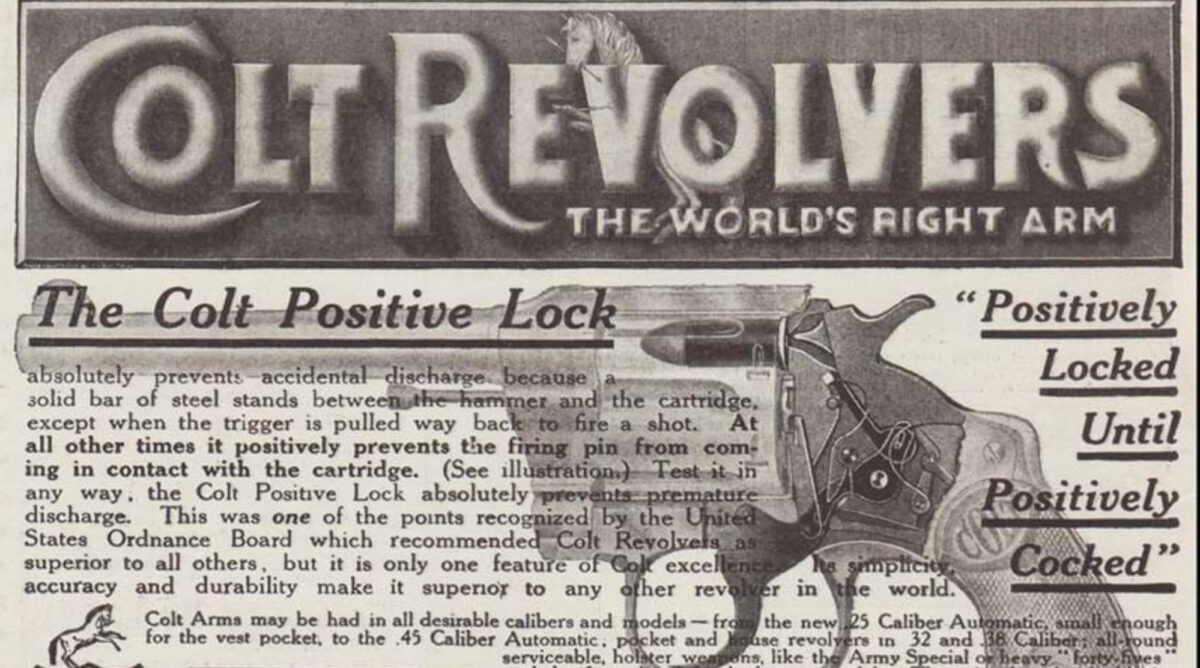
You mean I don’t have to wear
a baseball cap, sunglasses, grow
a beard and have “tactical”
clothing while lurking all the
time in a darkened back alley
to buy a gun?
Well, fiddle-dee-dee.
Yep, imagine that!
Colt should duplicate those ads today with the revolvers they make today. I agree 100% that the style of the ads was better. When I page through older gun magazines, these kinds of ads still catch my eye and make me pause and see them. Plastic, striker fired guns in the hands of tattooed and bearded Spec Ops models do nothing for me.
That would be neat, Steve! Maybe we need to talk to Justin B. about it.
Mike,
Thank you for your writings on various topics. I enjoyed your analysis of the Newhall tragedy. Your research and analysis to peel back the onion a few additional layers on the event was most enlightening. Your podcasts discussions on the current social / cultural environment was most appreciative to hear from an historian’s perspective.
Thank you for your efforts.
Thank you Sir! Very kind of you to say. I’m glad you got something out of them!
Mike, this post made me smile. If one suffers from a chronic case of nostalgia (I do), ads like these will take you to a happy place. Old magazines from that time frame and the ads in them are like therapy in this modern age. I love the ads for Tyler T Grips, Roy’s Original Holsters, S&W Holsters and ammo (back when they sold holsters and ammunition!), Ford Broncos and International Scouts. Things were pretty cool back then! Thank you, Sir.
Indeed. Someone once said something to the effect that, “the past is a foreign land,” and I think he was right. It feels like that was more than just a different time, but an entirely different place.
Lately I’ve been thinking about how the whole country rallied behind our Bicentennial, and celebrated it with pride, even though the country was in pretty rough shape, at the time. I’m hopeful the upcoming 250-year anniversary will help to rally the nation in a similar way, but I’m unsure.
I wish I could share photos of my reloading room; it’s almost all framed Colt ads and catalogs. There are some great old Smith ads too, but as indicated in the article Colt ads and catalogs were special.
As per the comment above about grim, sepia-toned tactical models that now proliferate gun ads I too am both exhausted and amused by them. When a waterfowl gun ad looks like a still from an ‘80s action film we’ve lost our way a bit. Don’t get me started on guns that include 2.0, tactical, elite, operator or spec ops in their name.
I dunno, Brent. Some of them ducks look a whole lot like Tangoes. Better mobilize the unit, get those choppers airborne, start prepping mags . . . but whatever you do, don’t shave!
It was indeed a different time. Most print advertising, not just gun ads, was extremely copy heavy by today’s standards. The TLDR consumer of today can’t be bothered with actual product information and tangible benefit statements. Modern advertising focuses more on identity and feelings. Vintage advertising did this too, but it was more subtely persuasive and less ham fisted than today. There is no time for nuance these days it seems.
Back in the 1960s, many monthly gun magazines had full color centerfolds of guns, much like the old Gun Digest books of the era. I guess most kids in high school had pin up girls or cars, but my bedroom wall was covered in color pictures of guns – Mauser, Colt, S&W, Ruger, Cheswinster, FN, Browning, Remington – and an array of WW-II military small arms, particularly of the bolt action genre.
The old Colt revolver ads in particular were very good at drawing one to their side – one extra shot, the solid cylinder lockup, the ability to shoot whatever load you could stuff into a .38 Special case. S&W let you know the Chief’s Special was even more compact and hideable. Either way, you felt totally confident in your duty -and off duty- revolver regardless whether it wore a prancing pony or a S&W (later joined by Ruger) on the side of the frame.
There was no S&W Combat Magnum Operator, no Colt Trooper Tacticool, no Ruger Range Ops – it was straight up out of the box a total fighting handgun, as good as you could ever want from the factory, and fully capable of helping you live to fight another day.
After market things were mostly limited to changing out the grips, adding speed loaders, different gun leather . . . that’s all you really needed. We didn’t know we had to have custom replacement triggers, firing pins, extractors, complete internal component overhauls, and God knows what else the plastic guns have today.
We knew when we left the gun store with that Colt Trooper Mk III, or that S&W Model 19 (66), or Combat Masterpiece, that all that was needed to hit the street with those guns was ammunition and a holster (preferrably after a range session to test function and sight in)
Ahhh, yes, they were the days.
How did you ever survive without all kinds of extra aftermarket add-ons? No Punisher Skulls for your Trooper? The Horror . . .
Well, I still go to monthly counselling meetings of old veteran troopers. We talk about how we survived with a six shot .357 Magnum (or .38 Special), one pair of handcuffs, drop pouches for 12 extra rounds for the revolver. How did we make it with no light rail on the revolver barrel, and no Picatinny rail for non-existent red dot optics? I mean, seriously, outside of changing the grip panels, or adding a grip adapter, what else could we do with our service weapon besides practice and put a few hundred rounds a month through it?
Last month we opined on how we ever managed with a lowly Remington 870 riding, quite literally, shotgun. The thought of not hitting the street without a Benelli M4 with side saddle shell carrier, forend mounted light was really depressing. Actually having to rack a slide after each shot made us realize how under gunned we really were. One of our group actually bought a Benelli M4, only to suffer so much equipment trauma that he sold it and bought a couple of Mossberg 590A1 pump guns.
I still don’t know how we made it without wearing BDU, load bearing vests, carrying 200 rounds of ammo, radio, ten sets of handcuffs, beard, goggles, elbow and knee protectors, and looking like we just spent 6 weeks in Fallujah. I mean, like our patrol cars didn’t have cages in them until the mid 1970s, and body armor came along about 1978.
There are a lot of guys in the group still suffering addictions to things like coffee and Krappy Kreme Donuts, other still smoke cigarettes stuffed into old Lucky Strike packs. One of the guys still carries two revolvers on him (blink, blink). It’s a struggle, but we all manage.
Re: the “cylinder bolt notches cut between the chambers” claim: I no longer own any Colt revolvers so I looked at images of the Detective Special and the Trooper on the magic picture box. Looks to me like the bolt notches are in identical places on the Colt and S&W revolvers, about halfway between the thinnest part of the chamber walls and the cylinder flutes, which would be “between the chambers.” So was I looking at the wrong models, or was Colt being less than candid? Or was I misinterpreting the statement?
I think, perhaps, Colt meant to compare their 6-shot Detective Special to S&W’s 5-shot Chiefs Special, in that regard? The bolt notches seem to be located in different spots on the Colt, from the pictures (I don’t have a Colt on hand to actually inspect, either). The S&W notches seem to be more centered between chambers, and the Colt notches slightly more offset, looking at external cues.
Today’s corporate marketing execs may be a different breed of cat from those of the good old days. My late brother-in -law graduated from a prestigious MBA school and moved right in as the marketing director for Cheerios. He took Cheerios to #1 (Oat Bran!). Then he took Wheaties to #2. This is what he told me:
MBA schools teach management by application of statistically proven practices. Got a problem? Apply the formula. A good MBA grad can supposedly manage any company. Deep knowledge of the product or loyalty to the brand is secondary. Just apply the formulas. Move up or move on.
Placement company “headhunters” keep tabs on promising MBA execs. If you’re not promoted vertically in five years you could be regarded as damaged goods. No room to move up? Better make a strong lateral move. B-I-L went from Wheaties to Robitussin (Shaq’s mom from the Wheaties connection) to Jergens cosmetics. The marketing formulas worked well for him. The formulas are apparently that image is everything. “You sell the sizzle, not the steak.”
Could be, Jeff, but I think we’ve lost something useful, along the way.